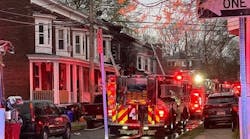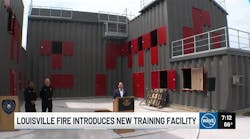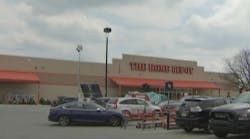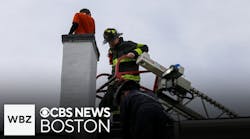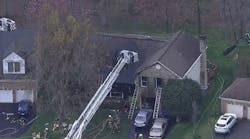There are differing opinions on opening the roof of a dwelling. The vast majority of dwelling fires involve only the contents, even though the fire can be accompanied by copious amounts of smoke that demands ventilation. My experience has found that fires in private dwellings of ordinary size do not normally necessitate the cutting of a ventilation hole in the roof unless the fire has heavily involved the attic or cockloft space. Even in many of these instances, a quick knockdown of the fire by the crews on the interior can be achieved and fires in these spaces controlled quickly. (Extremely large residences, containing more than 5,000 square feet and sometimes referred to as “McMansions” due to their size, must be assessed individually as to how to ventilate them.)
This does not stop firefighters from opening skylights or trimming ventilators that exist in the roof. Turbine-style roof ventilators are excellent for removing the heat that typically builds up in an attic or cockloft. Under fire conditions, the smoke and fire will be drawn to the ventilator and can pull a fire to uninvolved areas under the roof. Where rooftop ventilation in dwellings becomes imperative is when adjoining dwellings have common attics or cocklofts. If a fire in these buildings is suspected of entering the roof space, then the roof should be opened immediately. The venting of the fire directly upward to the exterior will assist in protecting the adjoining dwellings by preventing the mushrooming of the heat and smoke on the underside of the roof and spreading to the exposed buildings.
Fire coming from an opened skylight reinforces that the fire is in the living space. Fire emanating from the roof ventilator openings identifies that the fire involves the attic or cockloft. Fire involving the concealed spaces is a relevant piece of information for the incident commander and the units operating on the interior.
Similarly, progress reports from the interior will be used to guide the actions of those operating on the roof. A report that units are making good progress on the interior can be seen as a fire that will be controlled shortly and that the roof will probably not need to be opened. However, a report of increased high-heat conditions and little progress being made in advancing of hoselines, along with conditions observed on the roof, could indicate the need to place a ventilation opening in the roof. In many cases, these reports and the subsequent actions needed require immediate reactions. That is where experience is invaluable and why it is so important to critique a working fire so everyone can learn valuable lessons from each incident.
“Up and Over”
The “up and over” method of ventilation is often used in areas containing townhouses or rowhouses with flat roofs and limited access to the rear. A firefighter ascending a ladder placed at the front of the fire building performs horizontal ventilation by breaking windows there. Once on the roof, firefighters can reach over the roofline and break the rear windows. (This method can vary as to the efficiency of the ventilation.) Double- or triple-glazed windows require a tremendous amount of force to break open the glass to gain sufficient ventilation. A tool attached to a short utility rope can also be used in a swinging motion over the edge of the roof to gain more leverage to the blow striking the window glass. In any case, this is typically a stopgap measure until firefighters can access the rear with portable ladders to ensure that the window glass is fully broken out and any obstructions within the window opening are cleared.
Hoseline Operations On a Roof
Ventilation openings in a roof are not placed for the use of hoselines. Though a hoseline should be brought to the roof, its purpose is:
• To protect surrounding exposures that may be endangered by roof ventilation
• To protect the firefighters operating on the roof from being exposed to fire
• To protect their escape route
• To prevent flying embers
• To extinguish any roof fire that may occur during ventilation
Directing the hoseline into any roof opening defeats the purpose of the vent hole and it will drive the heat of the fire downward, endangering the firefighters below. Fire burning through a roof that is too weak to support firefighters should be allowed to burn through, creating an opening. The tendency to hit the fire with ladder pipes or other streams must be resisted. The self-venting that is created will be beneficial to the overall control efforts.
Using a Power Saw
Before a power saw is taken to a roof, it should be checked to see that the proper blade is in the saw and it should be started when it is taken off of the apparatus. Once it starts, it can be turned off and taken to the roof. Never climb a ladder with a running saw. If the saw does not start, get another saw to do the job. Before starting the saw, make sure there is a safe operating area. The firefighter operating the saw must ensure his or her own personal safety.
Know your equipment. Start the saw into the cut and work methodically. Do not attempt to rush the cut. It will only bind the saw. When a saw blade is bound in a cut, usually the cut (referred to as kerf) has to be spread to let the saw blade be freed. Knowledge beforehand of the saw’s limitations allows for a better fireground operation.
Know the type of roof surface and roof supports you will be operating on. Is it solid-beam or lightweight construction? The firefighter operating the saw must have a feel for the operation. He or she should not cut through roof supports. When a drag on the saw is felt, indicating a roof-supporting member, the saw should be allowed to ride over the supporting member, cutting only the roofing material leaving the supporting member intact.
The entire opening should be cut before attempting to pull back the roofing material. Opening it too soon creates a dangerous situation for the firefighter operating the saw since he or she will have to deal with heavier smoke and fire conditions. Do not allow anyone to use their hands near the saw to pull back the cut sections of the roof. Keep body parts away, including the feet of the firefighter operating the saw. When not in use, the saw should be shut off and set in a safe location. Do not put the saw down while the blade is still rotating.
Firefighters operating on the roof must be concerned with their own safety and that of the firefighters operating within the building below. Safe operations start in training. Preparation is the key. It starts with knowing your apparatus, your tools and your company’s capabilities. Be prepared for a variety of situations and consider potential solutions.
Let’s review some roof safety considerations in relation to construction, entry and egress from the roof and rooftop operations:
Roof Construction
The construction of the roof can affect firefighter safety:
• Lightweight wooden components subjected to fire will fail rapidly. This early failure endangers those beneath the roof and those operating on it.
• Steel bar-joist roofs can also be deadly to operate on. Subjected to fire, their failure times can resemble that of lightweight wood. The bar-joist is often set on much wider centers than the 16- to 24-inch centers routinely found on wood roofs. This creates a situation where failure of one roof joist can create a large opening in the roof.
• A timber-truss roof contains large wooden members. This allows the spacing of the roof members farther apart. Because of their larger size, a greater working time can be employed by firefighters operating on these roofs. However, it does not mean they will not fail. In fact, most timber-truss roofs contain various forms of steel connectors, which is the weak point of the truss. The conduction of the heat of the fire by the steel causes expansion of the steel and failure can and does occur. • The wide spacing between the individual truss means failure of one truss creates a gaping hole in a roof adding danger to those operating above it.
Entry and Egress
• If ladders will be used for firefighters to access the roof, ensure that they are of sufficient length and that they extend at least three rungs above the roofline. This allows for ease of mounting and dismounting the roof and assists in locating the ladder while on the roof.
• Keep alert for overhead electrical service wires attached to the building. Ensure that ladders do not contact them when the ladders are placed and that firefighters climbing the ladders will not come into contact with these wires.
• Is there a high parapet wall that must be navigated to get onto the roof? Will it interfere with a firefighter when exiting the roof, especially under emergency conditions?
• Should a small ladder be brought to the roof to overcome this problem?
• Ensure that there are two ways off of the roof. If portable ladders or fire escapes are being used as a means of egress from a roof, periodically check that heat and fire conditions have not made them untenable. (The interior built-in ladder contained in a roof scuttle is not a means of egress from the roof.)
• Under heavy smoke conditions, it may be necessary to attach a guideline to the head of the ladder to allow a quick return to its location to evacuate the roof.
• Is there is a lower roof level? Can a firefighter climb down or access it by using a hand tool and hanging from the higher roof to the lower roof for an emergency exit?
• Do not paint yourself into a corner while operating on a roof. Always keep an open corridor to at least one of your means of egress.
• Aerial ladders placed to a roof being used as a means of egress cannot be moved without notifying those on the roof depending on that ladder. Many fire departments have a standing order that once an aerial device is in operation, the engineer/operator must stay at the turntable or controls at all times. This seems like a minor point, but that engineer/operator knows why the aerial ladder is at that specific location and who is depending on it. Ideally, the aerial device should not be moved, but life-safety situations can arise where civilians or firefighters are trapped and they can be quickly removed with the aerial ladder.
Rooftop Operations
• Determine your objectives on the roof and carry them out in a safe manner.
• Use a tool to sound out the roof when initially mounting it. It lets the firefighter find the roof surface and help determine that it is sound. Finding the roof surface is usually routine, but in the case of a high parapet wall or an elevated cornice, the surface of the roof can be up to eight feet below the top of the cornice. A smoky nighttime fire with reduced visibility could injure an unsuspecting firefighter stepping from the cornice only to find no roof immediately underfoot.
• If the smoke conditions are severe, use a tool as a cane or a prod to ensure the soundness of the roof as you walk and to locate any openings. By sounding out or probing the roof with a tool, a firefighter can locate the roof surface and ensure stability. If unsure, get down on your knees and crawl, but continue to extend the tool outward, sounding out the roof as you advance.
• Constantly be aware of the conditions and your location on the roof.
• Do not take chances. Do not try and be a hero. If conditions do not allow an operation to be accomplished, inform the incident commander. Becoming injured on the roof will directly impact the overall operation. Your partner will be forced to tend to you. The incident commander will need to extricate you and your job assignment will not be accomplished. This alone can endanger those operating on the interior and affect the entire fireground effort.
• By spreading a portable ladder on the roof over a weakened area, a firefighter can spread his or her weight over the length of the ladder. If the roof stability is questionable, see whether it can be opened while operating from an adjoining roof.
• Operating from a platform or attached to a platform with a safety rope or belt is another method of ensuring firefighter safety.
• Beware of raised surfaces. Skylights or elevator shafts may be covered with roofing paper over the opening, setting up a dangerous situation for a firefighter stepping onto the surface.
• Do not walk across the center of the roof. Stay near the exterior walls or other bearing walls.
• Do not let too many firefighters on the roof. Keep only those necessary to safely perform the needed functions.
• Be aware of air or light shafts in the roof. They can be death traps for firefighters. Many firefighters who fall into these shafts knew of their presence, but during the firefighting effort, they were distracted and fell into these openings when they were hidden by heavy smoke.
• Skylights should be removed intact since falling glass can injure firefighters operating below. Being struck by glass from a skylight that has fallen a few stories while operating on or climbing stairs can cause serious injury. If unable to completely remove the skylight, it should be broken and pulled back onto the roof. Its presence will act as a warning to other firefighters of openings in the roof.
• Openings in roofs should be marked to prevent firefighters from falling into them. Another method that can be used is to place a portable ladder over the opening.
Summary
Teamwork at an incident scene is crucial. The firefighter making rescues can be hailed a hero. The firefighter on the nozzle gets the credit for extinguishing the fire. Yet without everyone completing their assignments correctly, the end result would be totally different.
Failure of any assignment can threaten the overall operation. The firefighter driving the engine must ensure that the apparatus and firefighters arrive safely and then assures an early and continuous water supply. Those performing forcible entry and laddering of a fire building facilitate entry and egress from the structure. Ventilation lets firefighters advance within the fire building as the smoke and heat is vented to the exterior.
The firefighters who are assigned to the roof have a large responsibility. In addition to vertical ventilation, the roof can be used as an observation post to get the big picture of the entire incident. The firefighters operating there must be the eyes and ears of the incident commander. The actions and information of the firefighters on the roof can mean the difference between success or failure at an incident scene.
